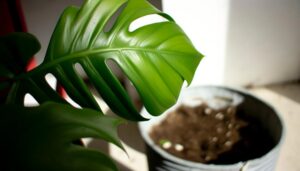White Spots on Monstera Deliciosa
White marks on your Monstera Deliciosa can originate from a variety of causes. Fungal infections like powdery mildew flourish in humid conditions, resulting in white patches.
Mineral deficiencies in calcium and magnesium may also appear as white marks. Pests such as mealybugs, spider mites, and scale insects can contribute, leaving behind residues that resemble white spots.
Environmental stressors, including inconsistent watering and low humidity, can further worsen the issue. Treatment options include applying fungicides, using neem oil for pests, and proper irrigation practices.
Addressing these factors correctly ensures long-term plant health and more details await in the inclusive guide.

Key Takeaways
- White spots can be caused by fungal infections like powdery mildew in humid conditions.
- Mineral deficiencies, particularly calcium and magnesium, may lead to white spots on leaves.
- Pest infestations such as mealybugs, spider mites, and scale insects can cause discoloration and white spots.
- Mineral deposits from hard water can appear as white spots; use distilled or rainwater to prevent this.
- Environmental stress factors like inconsistent watering and temperature fluctuations can contribute to the appearance of white spots.
Common Causes of White Spots
Identifying white spots on your Monstera Deliciosa typically involves examining several common causes, including fungal infections, pest infestations, and mineral deficiencies.
Fungal infections like powdery mildew manifest as white, powdery patches on leaves. They thrive in humid conditions and can spread rapidly if not controlled.
Mineral deficiencies, particularly calcium and magnesium, can also cause white spotting. Insufficient calcium disrupts cell wall formation, leading to leaf discoloration, while magnesium deficiency results in chlorosis, manifesting as white or yellowish specks.
To diagnose accurately, consider environmental factors, such as humidity and soil quality. Regularly inspect your plant under bright light to catch early signs.
Employing a balanced fertilization regime and maintaining ideal humidity can prevent these common issues effectively.
Identifying Pest Infestations
You'll need to identify common pests like spider mites, mealybugs, and scale insects, which often leave white spots on Monstera deliciosa. Examine the undersides of leaves and stems for tiny, moving specks or cotton-like patches.
Look for other signs of infestation, including webbing, honeydew secretion, and leaf discoloration.
Common Pests Identification
Spotting pests on your Monstera deliciosa often involves observing telltale signs such as small, white spots which could indicate infestations by common culprits like mealybugs, spider mites, or scale insects.
Mealybugs appear as tiny, cotton-like masses, secreting a waxy substance that disrupts photosynthesis. Spider mites, almost microscopic, create fine webs and leave stippling marks on leaves. Scale insects resemble small, immobile bumps that can sap plant importance by extracting sap.
To accurately identify these pests, use a magnifying glass to inspect the undersides of leaves and stems. Mealybugs cluster in leaf axils, spider mites thrive in dry conditions, and scale insects attach firmly to stems.
Recognizing these pests allows for targeted, effective management, ensuring your plant's health.
Signs of Infestation
When white spots appear on your Monstera deliciosa, they often signal a pest infestation that requires immediate attention. Identifying these intruders involves examining leaves for webbing, tiny insects, or discolored patches.
Spider mites, for instance, create fine silk threads and stippling on foliage. Scale insects manifest as small, immobile bumps, secreting honeydew that attracts sooty mold. Mealybugs appear as cotton-like masses, hiding in leaf axils. Aphids cluster on new growth, causing deformities and exuding sticky residues. Use a magnifying glass to inspect for these pests closely.
Early detection is crucial; untreated infestations can weaken the plant, stunting growth and leading to further complications. Addressing these signs promptly guarantees your Monstera remains healthy and vibrant.
Detecting Fungal Infections
Identifying fungal infections on Monstera Deliciosa involves scrutinizing the leaves for telltale signs such as powdery white spots, which may indicate the presence of fungal spores. You should also look for leaf discoloration and wilting, which are common symptoms of fungal activity.
| Symptom | Description |
|---|---|
| Powdery white spots | Indicate active fungal spore presence |
| Leaf discoloration | Yellowing or browning of leaf tissue |
| Wilting | Loss of leaf turgidity and structure |
| Mold growth | Visible fuzzy growth on the leaf surface |
These symptoms suggest the need for immediate intervention. Employ fungicides specifically designed for houseplants and guarantee proper air circulation around your Monstera. Regularly inspect your plant to catch infections early and mitigate damage.
Mineral Deposits on Leaves
You might notice white spots on your Monstera Deliciosa due to mineral deposits from hard water. These deposits form when water evaporates, leaving behind calcium and magnesium salts.
To prevent this, use distilled water and regularly wipe the leaves with a damp cloth to remove any buildup.
Causes of Mineral Deposits
Mineral deposits on Monstera deliciosa leaves often result from hard water, which contains high concentrations of calcium and magnesium. When you water your plant, these minerals can accumulate on the foliage, leaving unsightly white spots.
This typically happens due to:
- Evaporation: Water evaporates, leaving minerals behind.
- Overhead watering: Water splashes onto leaves, facilitating mineral build-up.
- Soil leaching: Minerals can move from soil to leaves through transpiration.
- Watering frequency: Frequent watering increases mineral deposition.
- Water quality: Tap water often contains high mineral content.
Understanding these causes allows you to identify the root of the problem. By recognizing the sources, you can take steps to mitigate the effects of mineral deposits on your Monstera deliciosa leaves.
Preventing White Spots
To prevent white spots caused by mineral deposits on your Monstera deliciosa, consider using distilled or rainwater for watering, as these options contain fewer impurities. Tap water often has high levels of calcium and magnesium, which can accumulate on leaves. By using purer water, you'll minimize the risk of these mineral deposits.
Additionally, make sure your plant has proper drainage to avoid water stagnation, which can worsen mineral buildup. Regularly flushing the soil with distilled water can also help remove excess salts.
Monitoring humidity levels is essential; low humidity can concentrate mineral deposits. Aim for a humidity level around 60%. These precautionary steps, rooted in scientific understanding, will help maintain your Monstera's pristine appearance and overall health.
Cleaning Affected Leaves
Given the persistence of mineral deposits on Monstera deliciosa leaves, employing a methodical approach to cleaning is essential for maintaining the plant's health and aesthetic appeal. You should use distilled or filtered water to avoid introducing additional minerals.
Gently wipe the leaves with a soft, damp cloth to remove surface deposits. For stubborn spots, consider a diluted vinegar solution. Here's a step-by-step guide:
- Mix one part white vinegar with three parts water.
- Dampen a cloth with the solution and gently wipe the affected areas.
- Rinse the leaves with distilled water to remove any residual vinegar.
- Dry the leaves with a clean, soft cloth to prevent water spots.
- Regularly inspect and clean to prevent buildup.
Environmental Stress Factors
Environmental stress factors, such as inconsistent watering schedules, sudden temperature fluctuations, and inadequate humidity levels, can greatly contribute to the appearance of white spots on your Monstera Deliciosa.
When you don't water the plant evenly, it may experience root stress, leading to nutrient imbalances that manifest as white spots.
Rapid changes in temperature, particularly cold drafts or heat spikes, can shock the plant, causing cellular damage visible on the leaves.
Low humidity levels also stress the Monstera, as it's native to tropical environments that provide steady moisture.
Effective Treatment Options
Addressing white spots on your Monstera Deliciosa involves a multifaceted approach focusing on optimizing watering practices, regulating temperature, and maintaining adequate humidity levels. Start by ensuring you're not overwatering; the soil should be moist but not waterlogged. Monitor ambient temperature, aiming for a stable range between 65-85°F to avoid stress.
Implement the following treatment strategies:
- Adjust Watering: Use well-draining soil and water only when the top inch is dry.
- Humidity Control: Maintain humidity around 60%, using a humidifier if necessary.
- Pest Management: Inspect leaves regularly for pests and treat with neem oil or insecticidal soap.
- Fungal Treatments: Apply fungicides to combat leaf spot diseases.
- Leaf Cleaning: Gently wipe leaves with a damp cloth to remove dust and potential pathogens.
These steps will help restore your Monstera's health.
Preventative Care Tips
To prevent white spots on your Monstera Deliciosa, consistently monitor and adjust environmental conditions such as light, moisture, and airflow. Guarantee your plant receives bright, indirect light, as direct sunlight can cause leaf burn, leading to white spots.
Maintain soil moisture by keeping it evenly damp but not waterlogged; overwatering fosters fungal growth. Regularly check for humidity levels, ideally between 60-70%, to prevent desiccation or excessive dampness.
Improve airflow around the plant by spacing it adequately and using a fan if necessary, which reduces stagnant air and fungal spore settlement. Periodically clean leaves to remove dust and potential pathogens, enhancing photosynthesis and overall plant vigor.
Long-term Plant Health
Maintaining long-term plant health for your Monstera Deliciosa involves not only consistent preventative care but also a strategic approach to nutrient management and pest control. Keeping an ideal environment is essential.
You'll need to monitor soil moisture levels meticulously, making sure they stay evenly moist but not waterlogged.
Implementing a strong fertilization regimen is crucial; use a well-rounded, water-soluble fertilizer to provide macro and micronutrients.
Pest control is also vital—regularly inspect the foliage for signs of infestation and treat promptly.
- Soil moisture uniformity: Keeps roots healthy.
- Well-rounded fertilization: Supplies essential nutrients.
- Pest examination: Prevents infestations.
- Humidity management: Reduces stress and prevents spots.
- Adequate illumination: Ensures photosynthesis efficiency.
Conclusion
Coincidentally, understanding white spots on your Monstera deliciosa can lead to a healthier plant overall. Pest infestations, fungal infections, mineral deposits, and environmental stress all play a role.
By identifying the cause, you can apply effective treatments and preventative measures. Regular monitoring and proactive care guarantee long-term plant health.
Embrace this knowledge, and you'll see your Monstera thrive, free of those pesky white spots.






